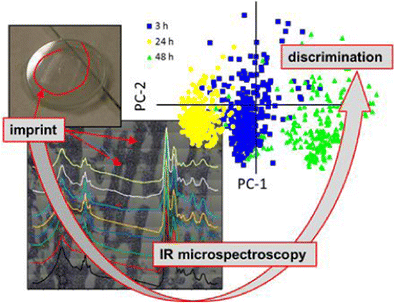Analytical and Bioanalytical Chemistry ( IF 4.3 ) Pub Date : 2018-04-18 , DOI: 10.1007/s00216-018-1049-z Ernesto Doncel-Pérez , Gary Ellis , Christophe Sandt , Peter S. Shuttleworth , Agatha Bastida , Julia Revuelta , Eduardo García-Junceda , Alfonso Fernández-Mayoralas , Leoncio Garrido
Therapeutic options for spinal cord injuries are severely limited; current treatments only offer symptomatic relief and rehabilitation focused on educating the individual on how to adapt to their new situation to make best possible use of their remaining function. Thus, new approaches are needed, and interest in the development of effective strategies to promote the repair of neural tracts in the central nervous system inspired us to prepare functional and highly anisotropic polymer scaffolds. In this work, an initial assessment of the behavior of rat neural progenitor cells (NPCs) seeded on poly(3-hydroxybutyrate-co-3-hydroxyhexanoate) fiber scaffolds using synchrotron-based infrared microspectroscopy (SIRMS) is described. Combined with a modified touch imprint cytology sample preparation method, this application of SIRMS enabled the biochemical profiles of NPCs on the coated polymer fibers to be determined. The results showed that changes in the lipid and amide I–II spectral regions are modulated by the type and coating of the substrate used and the culture time. SIRMS studies can provide valuable insight into the early-stage response of NPCs to the morphology and surface chemistry of a biomaterial, and could therefore be a useful tool in the preparation and optimization of cellular scaffolds.

Synchrotron IR microspectroscopy can provide insight into the response of neural progenitor cells to synthetic scaffolds
中文翻译:

同步加速器红外光谱法在静电纺聚酯纤维上生长的大鼠胚胎干细胞的生化分析
脊髓损伤的治疗选择受到严格限制。当前的治疗仅提供对症缓解和康复,其重点在于教育个人如何适应新情况以最大程度地利用其剩余功能。因此,需要新的方法,并且对发展有效策略以促进中枢神经系统中神经束修复的兴趣激发了我们制备功能性和高度各向异性的聚合物支架的兴趣。在这项工作中,接种在聚大鼠神经祖细胞(NPC)的行为的初步评估(3-羟基丁酸酯共描述了使用基于同步加速器的红外光谱法(SIRMS)的-3-羟基己酸酯纤维支架。结合改良的触摸式印迹细胞学样品制备方法,SIRMS的这种应用使得能够确定包覆聚合物纤维上NPC的生化特性。结果表明,脂质和酰胺I–II光谱区域的变化受所用底物的类型和涂层以及培养时间的调节。SIRMS研究可以为NPC对生物材料的形态和表面化学的早期反应提供有价值的见解,因此可以作为制备和优化细胞支架的有用工具。

同步加速器红外光谱可以深入了解神经祖细胞对合成支架的反应



























 京公网安备 11010802027423号
京公网安备 11010802027423号